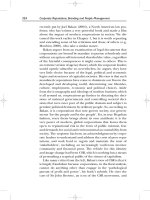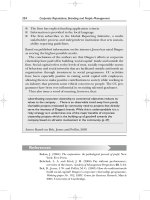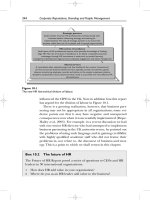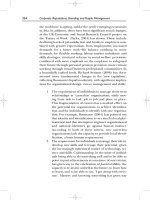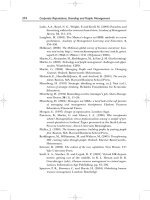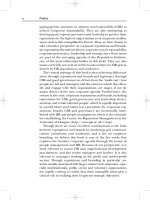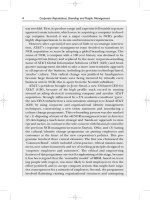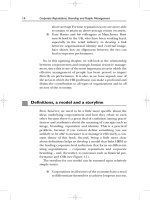Tài liệu Corporate Reputations, Branding and People Management 7 pdf
Bạn đang xem bản rút gọn của tài liệu. Xem và tải ngay bản đầy đủ của tài liệu tại đây (119.34 KB, 10 trang )
44 Corporate Reputations, Branding and People Management
Compelling place
to invest
Compelling place
to shop
Compelling place
to work
Customer retention
Customer impression
Merchandise
selection
Merchandise
returns
Image
Attitudes to
work
Managers’
knowledge and
behaviour
Work structure
Teamwork
Training
Attitudes to
company
Job context
Ethical context
Promotion
Pay etc.
Value for
money
Associates’ behaviour
Turnover
Revenue
growth
Profit
contribution
Figure 2.1
The employee–customer–profit chain at Sears (adapted from Kaplan and
Norton, 2001).
Further support for the central nature of the service encounter
came from a Gallup poll in the USA of six major sectors on the
factors influencing brand performance; it found that, for all
sectors, the single most important factor in building brand loy-
alty was employee behaviour (McEwen and Buckingham, 2001).
In the case of the airline industry, interaction with employees was
three times more powerful than any other factor, including
product performance. On the negative side, poor employee
performance was also important in customer dissatisfaction,
particularly when there were no other features to differentiate
among products or services. Nevertheless, the direct evidence
in support of this service–profit chain is not all that convincing.
Read the summary of a banking study in Box 2.1.
Chapter 2 Managing corporate brands and reputations 45
Box 2.1 The service–profit chain in the UK retail banking
industry
Garry Gelade and Stephen Young, two psychologists working for major
international consultants, have access to enormous data sets in the
British retail banking sector that allowed them to conduct a rigorous
study of the service–profit chain in four banks. Data were collected on
the attitudes of 37 000 employees to the jobs and organizations; they
also had access to customer satisfaction surveys and sales performance
at bank branch level.
These data allowed them to test the simple proposition of the serv-
ice–profit chain that ‘satisfied and motivated employees produce satisfied
customers, and satisfied customers tend to purchase more, increasing the
revenues and profits of the organization’ (Gelade and Young, 2005, p. 2).
The key link here is customer satisfaction being the mediating variable
between employee attitudes and organizational performance (see Figure
2.1). The model Gelade and Young used involved a causal relationship
linking positive employee perceptions of team working, job enablers and
job support to organizational climate and commitment. These people
management variables were thought to be the lead indicators of sales
achievement, though mediated by customer satisfaction.
Their data provided high levels of support for positive correlations of
employee attitudes and climate evaluations with customer satisfaction
and sales performance at the business unit level of analysis, i.e. the banks.
From these data, they concluded that, in theory at least, an improvement
As you can see from this discussion on the RBV and related
ideas such as the service–profit chain, brands and reputations
are dynamically linked to HRM. However, we need to be a little
clearer about what brands, branding and reputations mean
and how they are linked. We shall now discuss this question in
a little more detail.
Developments in branding and definitions
Proponents of branding view brands as the central organizing
principle for good management of a business and the most
important intangible asset that an organization can possess. By
and large, most big organizations with well-known brands,
whether in the for-profit or not-for-profit sectors, offer com-
modity products or services that can be relatively easily substi-
tuted by others. One only need examine the competitive
offerings of high profile brands such as Coca-Cola, Heinz,
HSBC, Wal-Mart, McDonald’s, Nokia, Ford or even Cancer
Research, and premium brands such as BMW and Moet-
Chandon to see this. What they do share, however, are three
attributes that distinguish them from their rivals: an attempt to
create a compelling idea, supporting core values and a role in the
organization that places brand positioning, purpose and values
46 Corporate Reputations, Branding and People Management
in one standard deviation from the mean of scores in employee commit-
ment would lead to an average 6% increase in bank sales. So if banks
worked very hard to achieve such improvements in attitudes by raising
average levels of commitment to at least the level of the most committed
top third of employees, they would reap significant benefits.
However, their data provided little support for the mediation effects
of customer satisfaction and, thus, the role it plays in the theory of the
service–profit chain. Though this should not be interpreted as meaning
customer satisfaction is irrelevant to the links between employee atti-
tudes and sales performance, other branding research also questions the
idea that customer satisfaction is closely associated with customers buy-
ing more or remaining loyal to the firm (Miller and Muir, 2004).
Source: Based on Gelade and Young, 2005
at the heart of all key decisions (Brymer, 2003; Sherry, 2005). Many
branding specialists share these ideas but offer additional
attributes as their own contributions to the meaning and value
of branding (see Box 2.2). They would also have little difficulty
in subscribing to a definition of brands that suggests more than
a name or symbol used to sell products and services, the usual
impression held by non-specialists. We offer our own variation
of a well-known definition by Kristin Zhivage as a working
one for this book. This incorporates the people management
dimension with the external view of marketers.
A brand is a promise made and kept in every strategic,
marketing and human resource activity, every action, every
corporate decision and every customer and employee
interaction intended to deliver strategic value to an
organization.
Chapter 2 Managing corporate brands and reputations 47
Box 2.2 Brands and business success
Jon Miller and David Muir (2004) are consultants who argue cogently
that brands and branding are, or should be, at the heart of business
and treated as a key approach to creating shareholder value. They
have identified five themes that are fundamental to understanding
brands:
■ Brands enhance the value of a product or service beyond its func-
tional value, so enabling organizations to gain by selling more
and/or charging higher prices. By generating better cash flows,
they help create shareholder value.
■ Brands are the source of alignment between an organization and
its stakeholders, providing the basis for continuity and trust. Trust
and loyalty, not just satisfied customers, are what generate revenues
and long-term sales performances.
■ Brands are the outcomes of behaviour – every action taken by mem-
bers of an organization has the potential to influence a brand repu-
tation, for good or bad. Brand promises create expectations that
are judged by the behaviour of organizational decisions and actions;
promises have to be matched by delivery in every action, decision
and customer interaction.
The value of brands
As noted in Chapter 1, the economic and social value of brands
to organizations is increasing significantly. Studies by academics
and consultants have shown that the contribution of brands to
the top-branded companies can contribute between 20 and 70%
48 Corporate Reputations, Branding and People Management
Box 2.3 Evian: an exceptional case that proves the rule?
We have made the claims that brands and reputations are usually driven
from the inside and that many brands are built on commodity products
which are easily substituted. Evian demonstrates how powerful market-
ing and branding can be in creating a brand from a commodity like
water; however HR and people management seem to have no part to play
in this success. But is this case unique and the exception that proves the
rule that ‘it all stems from people’?
Evian water began life as a medicinal product in the 19th century
sourced in Evian-les-Bains on the shores of Lake Geneva, overlooked
by the Alps. Matt Haig (2004) points out that the success of this prod-
uct, sold in 120 countries and brand leader in the increasingly popular
mineral water market, is remarkable, because it costs many times more
than ordinary and free tap water, which is sometimes more pure than
bottled water, and tastes little or no different. So what is behind its suc-
cess? Clearly not price and product quality. According to Haig, it is the
purity of its branding that has driven Evian into its leading position.
Evian is marketed as a pure water, filtered many times, ‘untouched
by man’, in an idyllic Alpine setting. It is also pure in the sense that
there have been no attempts to extend the brand into other water
products, such as fruit-flavours or sparkling water. In these senses, its
success seems to be driven by marketing and image-making, which bene-
fits from its chilly Alpine associations and from health and lifestyle
advice that tells us to drink more water.
■ Brands only exist in the minds of people – they are perceptions held
by consumers and are therefore public objects, not only assets of the
organization. It is in this sense that people can be said to ‘own’ brands.
■ Brands can provide organizations with purpose and direction,
helping align stakeholders behind the brand. In this sense, brand-
ing should be part of the vision and mission of the organization.
